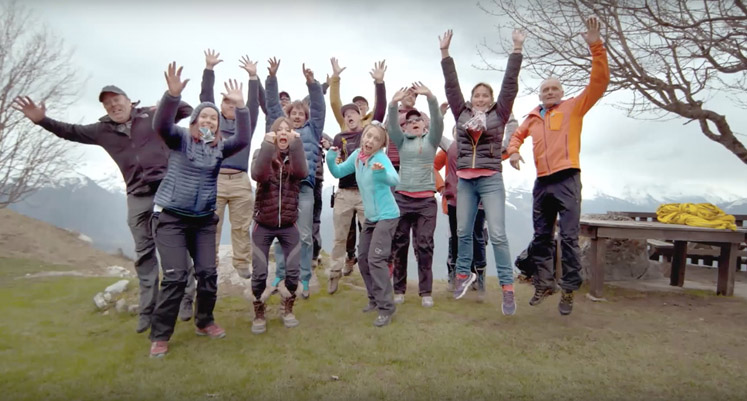Get our latest industry insights and news in your inbox.
Most of us don’t go to work in order to jump off mountains. But we do stake much of our self-worth—our sense of success, our livelihoods—on what we do. Sometimes we bet so big that we refuse to trust team members or colleagues to bring their expertise to a project. With the pressure mounting, we turn inward, channeling self-reliance and the Hero’s Journey.
But the power of teams is well-documented. And the truth is that—despite thousands of years of myth-making about the individual—we’re more likely to accomplish goals when we work together.
In January 2019, Oxygen hosted a fantastic live conversation with wingsuit BASE-jumper Ellen Brennan and Oxygen CEO Juliana Stancampiano. Ellen pulled off a never-been-done-before flight for a Dunkin’ Donuts ad back in 2016. Ellen and team also shared a remarkable behind the scenes featurette, with their teamwork and trust front and center. It hits on the rush of a great experience and showcases people iterating to achieve an outcome that’d never been done before.
This is teamwork at its finest: twenty-two people working in the Alps to help a wingsuiter to hit a target, flying just six feet above the ground at about 120 MPH.

During her conversation with Oxygen, Ellen spoke beautifully about the necessity of having the right people on her team.
"Having a good team is really key, but also trusting those team members to do their job is also so important. I knew that my safety advisor would do his job, I knew my [parachute] packers would do their job well. As soon as I gave them a task, I could forget about it because I knew they could do it."
When someone’s life is on the line, trust and professional respect are paramount. If someone on Ellen’s team doesn’t speak up when they need help, or come clean when they sense danger or bout, the consequences are very real and very dire.
Work isn’t that way for most of us—we don’t routinely stare death in the face to fulfill each line of a contract. But, when pressure to meet expectations mounts, we sometimes turn inward and spend more time thinking about the consequences of failing instead of reaching out for help to move forward and make progress. Even though we aren’t physically stepping off a cliff or mountainside, sometimes it takes a similar courage to admit we don’t have the answer and need to rely on our colleagues. Speaking with Ellen,Juliana rightly wondered what holds the world of work back from adopting a model like the one on display in Ellen’s stunt.
“Different people on the team play different critical roles,” Juliana explained. “And when you’re in these life-or-death situations, having that trust is huge. But at work, the stakes aren’t that high–and then it becomes acceptable to become more complacent about fostering trust.
But what if those stakes were higher at work? What would we do on the team? Would we contribute and say, ‘Hey, this is what our strength really is. This is how I can best contribute to the business outcome we’re driving.”

The idea bears some consideration. In this world of always-on, always-connected work, who among us hasn’t taken on more responsibility that they could reasonably handle in a given day or week, because they thought this was expected of them? Who hasn’t worked late, trying to fit in those last minute emails or slide deck tweaks at 9PM, when it actually signals that we have too much on our plates? For the learning professionals in the audience:how many times have we charged ourselves with being the expert on a new topic to deliver to our audiences, not realizing that asking for help would help us find the people in organization who actually could contribute in a meaningful way?
How should teaming actually feel?
“Our working world provides countless opportunity and possibility to view things that might have seemed like obstacles or challenges as an individual, and instead view them as just part of what happens on a team,” Juliana wrote in her book Radical Outcomes: How To Create Extraordinary Teams That Get Tangible Results. “For example, you may know stakeholders who seem intimidating, either because they might disagree, or have broad responsibilities, or deep expertise in something.In reality, they are just part of your team. Without you, they aren’t going to be successful either.”
At Oxygen, we refer to these teams as ensembles.We like the term, because it makes us think of the performance arts, where groups of people who are keenly attuned to each other’s actions create together—often using body language and agreed upon principles that describe how to interact—without an exact roadmap, or at least with an understanding that the outcome might look different than expected by the time they’re done.
Ellen’s BASE-jumping team definitely had an exact outcome, and many teams at work do too. Though most of us aren’t flying off cliffs Monday-Friday, that doesn’t prevent us from sharing responsibility and relying on each other’s differing skillsets and areas of expertise. Placing trust in each other at work can help us perform as teams to meet the ever-changing demands and pace of our world of work.
But all of this discussion about the similarities and correlations between Oxygen and Team of Teams isn’t just to puff ourselves up. Really, we’re proud to have such an adaptive company, because truly, as McChrystal writes:
The organization as a rigidly reductionist mechanical beast is an endangered species. The speed and interconnected nature of the new world in which we function have rendered it too stupid and slow to survive the onslaught of predators.
Translated, that means: people at work need an alternative to how they work today, and they need it now. And the more ways that we can help articulate it, the better.